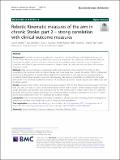| dc.contributor.author | Moretti, Caio B. | |
| dc.contributor.author | Hamilton, Taya | |
| dc.contributor.author | Edwards, Dylan J. | |
| dc.contributor.author | Peltz, Avrielle R. | |
| dc.contributor.author | Chang, Johanna L. | |
| dc.contributor.author | Cortes, Mar | |
| dc.contributor.author | Delbe, Alexandre C. B. | |
| dc.contributor.author | Volpe, Bruce T. | |
| dc.contributor.author | Krebs, Hermano I. | |
| dc.date.accessioned | 2022-01-03T17:12:50Z | |
| dc.date.available | 2022-01-03T17:12:50Z | |
| dc.date.issued | 2021-12-29 | |
| dc.identifier.issn | 332-8886 | |
| dc.identifier.uri | https://hdl.handle.net/1721.1/138774 | |
| dc.description.abstract | Abstract
Background
A detailed sensorimotor evaluation is essential in planning effective, individualized therapy post-stroke. Robotic kinematic assay may offer better accuracy and resolution to understand stroke recovery. Here we investigate the added value of distal wrist measurement to a proximal robotic kinematic assay to improve its correlation with clinical upper extremity measures in chronic stroke. Secondly, we compare linear and nonlinear regression models.
Methods
Data was sourced from a multicenter randomized controlled trial conducted from 2012 to 2016, investigating the combined effect of robotic therapy and transcranial direct current stimulation (tDCS). 24 kinematic metrics were derived from 4 shoulder-elbow tasks and 35 metrics from 3 wrist and forearm evaluation tasks. A correlation-based feature selection was performed, keeping only features substantially correlated with the target attribute (R > 0.5.) Nonlinear models took the form of a multilayer perceptron neural network: one hidden layer and one linear output.
Results
Shoulder-elbow metrics showed a significant correlation with the Fugl Meyer Assessment (upper extremity, FMA-UE), with a R = 0.82 (P < 0.001) for the linear model and R = 0.88 (P < 0.001) for the nonlinear model. Similarly, a high correlation was found for wrist kinematics and the FMA-UE (R = 0.91 (P < 0.001) and R = 0.92 (P < 0.001) for the linear and nonlinear model respectively). The combined analysis produced a correlation of R = 0.91 (P < 0.001) for the linear model and R = 0.91 (P < 0.001) for the nonlinear model.
Conclusions
Distal wrist kinematics were highly correlated to clinical outcomes, warranting future investigation to explore our nonlinear wrist model with acute or subacute stroke populations.
Trial registration
http://www.clinicaltrials.gov
. Actual study start date September 2012. First registered on 15 November 2012. Retrospectively registered. Unique identifiers:
NCT01726673
and
NCT03562663
. | en_US |
| dc.publisher | BioMed Central | en_US |
| dc.relation.isversionof | https://doi.org/10.1186/s42234-021-00082-8 | en_US |
| dc.rights | Creative Commons Attribution | en_US |
| dc.rights.uri | https://creativecommons.org/licenses/by/4.0/ | en_US |
| dc.source | BioMed Central | en_US |
| dc.title | Robotic Kinematic measures of the arm in chronic Stroke: part 2 – strong correlation with clinical outcome measures | en_US |
| dc.type | Article | en_US |
| dc.identifier.citation | Bioelectronic Medicine. 2021 Dec 29;7(1):21 | en_US |
| dc.contributor.department | Massachusetts Institute of Technology. Department of Mechanical Engineering | |
| dc.relation.journal | Bioelectronic Medicine | en_US |
| dc.eprint.version | Final published version | en_US |
| dc.type.uri | http://purl.org/eprint/type/JournalArticle | en_US |
| eprint.status | http://purl.org/eprint/status/PeerReviewed | en_US |
| dc.date.updated | 2022-01-02T04:10:32Z | |
| dc.language.rfc3066 | en | |
| dc.rights.holder | The Author(s) | |
| dspace.date.submission | 2022-01-02T04:10:32Z | |
| mit.journal.volume | 7 | en_US |
| mit.license | PUBLISHER_CC | |
| mit.metadata.status | Authority Work Needed | en_US |
